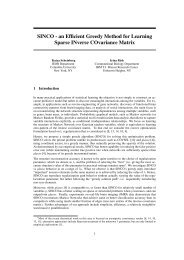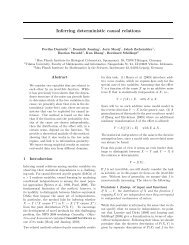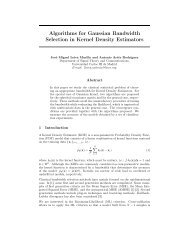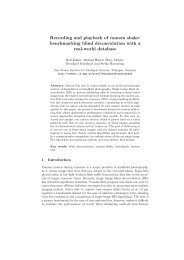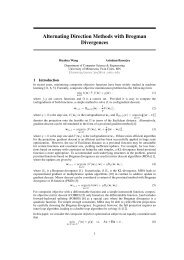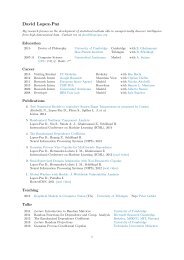Stochastic optimization with non-iid noise - Optimization for Machine ...
Stochastic optimization with non-iid noise - Optimization for Machine ...
Stochastic optimization with non-iid noise - Optimization for Machine ...
You also want an ePaper? Increase the reach of your titles
YUMPU automatically turns print PDFs into web optimized ePapers that Google loves.
(b) <strong>with</strong> probability at least 1 − 2δ, <strong>for</strong> any τ ∈ N the predictor ̂x T satisfies<br />
f(̂x T ) − f(x ∗ ) ≤ 1 T R T + τG √ T∑<br />
2τ<br />
κ(t) + 2GR<br />
T<br />
T log 2τ δ + 2β(τ)GR<br />
δ<br />
t=1<br />
+ τGR<br />
T .<br />
To better illustrate our results, we now specialize them under concrete mixing assumptions.<br />
We begin <strong>with</strong> a corollary giving error bounds <strong>for</strong> geometrically φ-mixing processes (as<br />
defined in Section 2).<br />
Corollary 1. In addition to the conditions of Theorem 2(a), assume φ(k) ≤ φ 0 exp(−φ 1 k θ ).<br />
There exists a finite universal constant C such that <strong>with</strong> probability at least 1 − δ<br />
f(̂x T ) − f(x ∗ ) ≤ 1 [ (log T ) 1/θ<br />
T R G<br />
T + C ·<br />
T φ 1<br />
T ∑<br />
t=1<br />
κ(t) + GR<br />
√<br />
(log T ) 1/θ<br />
φ 1 T<br />
log<br />
(log T )1/θ<br />
δ<br />
Under geometric φ-mixing, the probabilistic terms are of the same order as the i.i.d. setting<br />
[3] to <strong>with</strong>in poly-logarithmic factors. Algebraic mixing yields somewhat slower rates<br />
(see the full version [1] of this paper). More generally, under the same condition on the stability,<br />
an argument similar to that <strong>for</strong> Corollary 7 of Duchi et al. [5] implies f(̂x T ) −f(x ∗ ) → 0<br />
<strong>with</strong> probability one when φ(k) → 0 as k → ∞. Theorem 2(b) can also be extended to<br />
similar corollaries but we omit such discussion here due to lack of space.<br />
To obtain a concrete convergence rate from our results, we need to know bounds on the<br />
stability sequence κ(t) (and the regret R T ). Indeed, <strong>for</strong> two common first-order methods,<br />
online mirror-descent (see e.g. Theorem 11.1 of [4] or the paper [12]) and regularized<br />
dual averaging [16], known convergence results combined <strong>with</strong> Theorem 2 give that <strong>with</strong><br />
probability at least 1 − δ,<br />
f(̂x T ) − f(x ∗ ) ≤ 1 [ GRτ<br />
T R T + C · inf √ + GR √<br />
√ τ log τ ]<br />
τ∈N T T δ + φ(τ)GR , (7)<br />
<strong>for</strong> some universal constant C. The bound (7) captures the known convergence rates <strong>for</strong> i.i.d.<br />
sequences [3, 12, 16, 4] by taking τ = 1, since φ(1) = 0. Further specializing<br />
√<br />
to the geometric<br />
mixing rate of Corollary 1, one obtains an error bound of O(1/(φ 1 T )) to poly-logarithmic<br />
factors; this is essentially same as the generalization error in i.i.d. settings.<br />
3.2 Convergence rates <strong>for</strong> strongly convex functions<br />
It is by now well-known that the regret of online learning algorithms scales as O(log T ) <strong>for</strong><br />
strongly convex functions, a result which is originally due to Hazan et al. [6]. Many online<br />
algorithms, including gradient and mirror descent [2, 6, 15] and dual averaging [16, Lemma<br />
10], satisfy the stability bound ‖x(t) − x(t + 1)‖ ≤ G/(σt) when the loss functions are σ-<br />
strongly convex. Under these conditions, Theorem 1 gives an expected generalization bound<br />
of<br />
√<br />
O(inf τ∈N {β(τ) + τ log T/T }), which is faster than the standard rate of O(inf τ∈N {β(τ) +<br />
τ/T }), but the improvement in rates does not directly apply to Theorem 2. In the next<br />
theorem, we derive sharper guarantees when the expected function f is strongly convex by<br />
extending a self-bounding martingale argument due to Kakade and Tewari [8].<br />
Theorem 3. Let Assumptions A–C hold. For any δ < 1/e, T ≥ 3, <strong>with</strong> probability at least<br />
1 − 4δ log n, <strong>for</strong> any τ ∈ N the predictor ̂x T satisfies<br />
f(̂x T ) − f(x ∗ ) ≤ 2 T R T + 2τG<br />
T<br />
T∑<br />
t=1<br />
κ(t) + 32G2 τ<br />
σT<br />
log τ δ + 4τRG<br />
T<br />
]<br />
.<br />
(3 log τ δ + 1 )<br />
+ 2RGφ(τ).<br />
We can establish the following corollary under the previously mentioned stability bound<br />
‖x(t) − x(t + 1)‖ ≤ G/(σt) <strong>for</strong> strongly convex online learning algorithms.<br />
Corollary 2. In addition to the conditions of Theorem 3, assume the stability bound κ(t) ≤<br />
G/σt. There is a universal constant C such that <strong>with</strong> probability at least 1 − 4δ log T ,<br />
f(̂x T ) − f(x ∗ ) ≤ 2 T R T + C · inf<br />
τ∈N<br />
[ τG<br />
2<br />
σT<br />
log T +<br />
τG2<br />
σT log τ δ + G2<br />
σ φ(τ) ]<br />
.<br />
4



